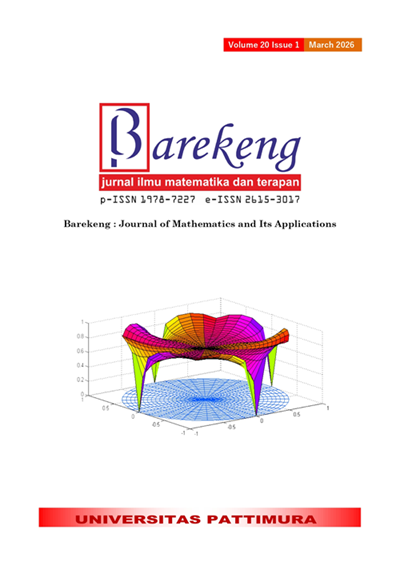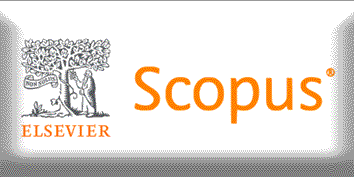MODELING AND FORECASTING MORTALITY RATES DURING THE COVID-19 PANDEMIC USING THE SECOND ADAPTED NOLFI MODEL AND AUTO ARIMA
Abstract
Modeling and forecasting mortality rates have been widely performed using various approaches. One such approach is the Second Adapted Nolfi model, which is one of three adaptations derived from the Nolfi and Generalized Nolfi models. Unfortunately, its application remains limited compared to widely used models like Lee-Carter and Cairns-Blake-Dowd. Previous studies on this model have shown satisfactory performance, particularly in residual analysis. However, those studies were conducted before the COVID-19 pandemic, and no study has yet applied it in the pandemic or post-pandemic periods. Although the pandemic may appear less relevant in 2025, the absence of such studies highlights the importance of further investigation into the model’s performance under extreme demographic conditions. This study addresses that gap by evaluating the Second Adapted Nolfi model using data from the Human Mortality Database (HMD) for the United States, the United Kingdom, and Italy. The model was applied to data up to 2019, and Auto-ARIMA was used to forecast from 2020 onward. The modeling results indicate that the logarithmic mortality curves align with established patterns, such as high rates at age 0, a decline through childhood, a sharp increase in early adulthood, and a continued rise into old age. The results also show that HMD mortality rates exceed the forecasted values for individuals aged 80 and above, suggesting increased elderly mortality during the pandemic. Three error metrics were used, yielding RMSE values from 0.01 to 0.18, MAE from 0.004 to 0.07, and MAPE from 28 to 286. Although Italy had the highest MAPE, the United States and the United Kingdom also showed notable errors. These findings reveal both the pandemic’s demographic impact and limitations of the model in capturing sudden shocks. Future studies may enhance this model through new adaptations, further comparison with other models, or alternative smoothing techniques to develop more robust mortality forecasts.
Downloads
References
M. R. Rahim, D. Dwi Sanyoto, E. Istiqamah, R. Adhani, and Husaini, “ANALYSIS OF FACTORS ASSOCIATED WITH MATERNAL MORTALITY RATES,” Jurnal Surya Medika (JSM), vol. 10, no. 3, pp. 365–373, Dec. 2025. doi: https://doi.org/10.33084/jsm.v10i3.9204
A. Mustofa and R. Alifa, “STRATEGIES TO REDUCE MATERNAL AND CHILD MORTALITY RATES THROUGH ‘BUAIAN SERVICES’ IN EAST JAVA,” JAP (Jurnal Administrasi Publik), vol. 15, no. 2, pp. 1–14, Dec. 2024. doi: https://doi.org/10.31506/jap.v15i2.26063
G. A. Setiady and F. Kusnadi, “INDONESIAN NATIONAL MORTALITY RATES USING THE WHITTAKER-HENDERSON GRADUATION METHOD,” JTAM (Jurnal Teori dan Aplikasi Matematika), vol. 8, no. 4, p. 1292, Oct. 2024. doi: https://doi.org/10.31764/jtam.v8i4.26316
T. Saifudin et al., “COMPARISON OF POISSON REGRESSION AND GENERALIZED POISSON REGRESSION IN MODELING THE NUMBER OF INFANT MORTALITY IN WEST JAVA 2022,” BAREKENG: Journal of Mathematics and Its Applications, vol. 19, no. 1, pp. 35–50, Jan. 2025. doi: https://doi.org/10.30598/barekengvol19iss1pp35-50
A. H. A. Zili, S. Mardiyati, and D. Lestari, “FORECASTING INDONESIAN MORTALITY RATES USING THE LEE-CARTER MODEL AND ARIMA METHOD,” in AIP Conference Proceedings, 2018. doi: https://doi.org/10.1063/1.5064209
Rowan, L. Muflikhah, and I. Cholissodin, “PERAMALAN KASUS POSITIF COVID-19 DI JAWA TIMUR MENGGUNAKAN METODE HYBRID ARIMA-LSTM,” Jurnal Pengembangan Teknologi Informasi dan Ilmu Komputer, vol. 6, no. 9, pp. 4146–4153, Sep. 2022, [Online]. Available: http://j-ptiik.ub.ac.id.
N. Lediwara, A. K. Heikmakhtiar, S. D. Bimorogo, A. N. Xaviera, A. Hijrianisa, and A. K. Hapsari, “PREDIKSI JUMLAH KASUS COVID-19 DI JAWA BARAT MENGGUNAKAN METODE ARIMA,” Jurnal TNI Angkatan Udara, vol. 3, no. 1, 2024. doi: https://doi.org/10.62828/jpb.v3i1.92
A. K. Rachmawati, “PERAMALAN PENYEBARAN JUMLAH KASUS VIRUS COVID-19 PROVINSI JAWA TENGAH DENGAN METODE ARIMA,” Zeta - Math Journal, vol. 6, no. 1, 2020. doi: https://doi.org/10.31102/zeta.2021.6.1.11-16
F. Widhiatmoko, D. Danardono, M. Kurniawaty, A. N. Maydika, T. S. D. Nishi, and C. Idris, “THE APPLICATION OF ARIMA AND RESIDUAL BOOTSTRAP FOR FORECASTING DYNAMIC MORTALITY IN THE PLAT MODEL FOR INDONESIAN MALE POPULATION,” Jurnal Matematika, Statistika dan Komputasi, vol. 21, no. 2, pp. 482–501, Jan. 2025. doi: https://doi.org/10.20956/j.v21i2.41403
N. Padrot, “DIE BERÜCKSICHTIGUNG DER STERBLICHKEITSVERBESSERUNG IN DER RENTENVERSICHERUNG NACH DER OPTIMALMETHODE DER SPIELTHEORIE,” Bulletin / Association of Swiss Actuaries, no. 59, 1959. doi: https://doi.org/10.5169/seals-966809.
L. H, K. P.L, and B. K, “ADAPTIVE ALGORITHMIC ANNUITIES,” Bulletin / Swiss Association of Actuaries, 2001, doi: https://doi.org/10.5169/seals-967351.
G. Binder, “CONSTRUCTION AND COMPARISON OF MORTALITY TABLES BASED ON DIFFERENT TECHNIQUES,” Swiss Federal Institute of Technology Zurich, Zürich, 2014.
M. D. P. Martinasari, “PEMBENTUKAN TABEL MORTALITA MENGGUNAKAN MODEL NOLFI, GENERALISASI NOLFI, DAN ADAPTASI NOLFI,” Gadjah Mada University, Yogyakarta, 2018.
S. Schnürch, T. Kleinow, and A. Wagner, “ACCOUNTING FOR COVID-19-TYPE SHOCKS IN MORTALITY MODELING: A COMPARATIVE STUDY,” J Demogr Economics, vol. 89, no. 3, pp. 483–512, Sep. 2023. doi: https://doi.org/10.1017/dem.2023.9
M. S. Anggreainy, A. M. Illyasu, H. Musyaffa, and F. H. Kansil, “ANALYSIS OF FACTORS INFLUENCING THE COVID-19 MORTALITY RATE IN INDONESIA USING ZERO INFLATED NEGATIVE BINOMIAL MODEL,” Int J Adv Comput Sci Appl, vol. 13, no. 4, pp. 728–734, 2022. doi: https://doi.org/10.14569/IJACSA.2022.0130485
R. A. Al-Qazzaz and S. A. Yousif, “HIGH PERFORMANCE TIME SERIES MODELS USING AUTO AUTOREGRESSIVE INTEGRATED MOVING AVERAGE,” Indonesian Journal of Electrical Engineering and Computer Science, vol. 27, no. 1, pp. 422–430, Jul. 2022, doi: 10.11591/ijeecs.v27.i1.pp422-430. doi: https://doi.org/10.11591/ijeecs.v27.i1.pp422-430
T. M. Awan and F. Aslam, “PREDICTION OF DAILY COVID-19 CASES IN EUROPEAN COUNTRIES USING AUTOMATIC ARIMA MODEL,” 2020. [Online]. Available: https://github.com/CSSEGISandData/COVID-19/tree/master/. doi: https://doi.org/10.4081/jphr.2020.1765
S. Shareef, S. Akhtar, N. Tufail, F. Ahmad, and M. Imran, “TREND ANALYSIS OF COVID-19 CASES IN PAKISTAN,” Journal of University Medical and Dental College, vol. 13, no. 1, pp. 299–303, Jan. 2022, doi: 10.37723/jumdc.v12i4.655. doi: https://doi.org/10.37723/jumdc.v13i1.655
World Health Organization, “WHO HEALTH EMERGENCIES PROGRAMME: WHO COVID-19 DASHBOARD.”
H. Pratyaksa, A. E. Permanasari, and S. Fauziati, “UTILIZATION OF WHITTAKER-HENDERSON SMOOTHING METHOD FOR IMPROVING NEURAL NETWORK FORECASTING ACCURACY,” Jurnal Nasional Teknik Elektro dan Teknologi Informasi, vol. 11, no. 1, Feb. 2022. doi: https://doi.org/10.22146/jnteti.v11i1.3489
M. E. Chanco, “MORTALITY RATES ESTIMATION USING WHITTAKER-HENDERSON GRADUATION TECHNIQUE,” Journal of the Mathematical Society of the Philippines ISSN, vol. 39, 2016.
J. Goes, K. Barigou, and A. Leucht, “BAYESIAN MORTALITY MODELLING WITH PANDEMICS: A VANISHING JUMP APPROACH,” J R Stat Soc Ser C Appl Stat, vol. 74, no. 2, pp. 373–390, Mar. 2025, [Online]. Available: http://arxiv.org/abs/2311.04920
Ş. Şahin and S. Özen, “A QUANTITATIVE COMPARISON OF MORTALITY MODELS WITH JUMPS: PRE- AND POST-COVID INSIGHTS ON INSURANCE PRICING,” Risks, vol. 12, no. 3, pp. 1–24, Mar. 2024, doi: https://doi.org/10.3390/risks12030053
K. Sahoo, A. K. Samal, J. Pramanik, and S. K. Pani, “EXPLORATORY DATA ANALYSIS USING PYTHON,” International Journal of Innovative Technology and Exploring Engineering (IJITEE), vol. 8, no. 12, pp. 4727–4735, Oct. 2019. doi: https://doi.org/10.35940/ijitee.L3591.1081219.
M. Waskom, “SEABORN, CHOOSING COLOR PALETTES.” Accessed: Sep. 13, 2025. [Online]. Available: https://seaborn.pydata.org/tutorial/color_palettes.html
T. G. Smith, “PMDARIMA.ARIMA.AUTO_ARIMA.” Accessed: Sep. 13, 2025. [Online]. Available: https://alkaline-ml.com/pmdarima/modules/generated/pmdarima.arima.auto_arima.html
J. Goes, K. Barigou, and A. Leucht, “BAYESIAN MORTALITY MODELLING WITH PANDEMICS: A VANISHING JUMP APPROACH,” J R Stat Soc Ser C Appl Stat, vol. 74, no. 2, pp. 373–390, Mar. 2025, [Online]. Available: http://arxiv.org/abs/2311.04920
Ş. Şahin and S. Özen, “A QUANTITATIVE COMPARISON OF MORTALITY MODELS WITH JUMPS: PRE- AND POST-COVID INSIGHTS ON INSURANCE PRICING,” Risks, vol. 12, no. 3, pp. 1–24, Mar. 2024. doi: https://doi.org/10.3390/risks12030053
Copyright (c) 2025 Made Diyah_Putri Martinasari, Krishna Prafidya Romantica, Putu Tika Dinda Gentari

This work is licensed under a Creative Commons Attribution-ShareAlike 4.0 International License.
Authors who publish with this Journal agree to the following terms:
- Author retain copyright and grant the journal right of first publication with the work simultaneously licensed under a creative commons attribution license that allow others to share the work within an acknowledgement of the work’s authorship and initial publication of this journal.
- Authors are able to enter into separate, additional contractual arrangement for the non-exclusive distribution of the journal’s published version of the work (e.g. acknowledgement of its initial publication in this journal).
- Authors are permitted and encouraged to post their work online (e.g. in institutional repositories or on their websites) prior to and during the submission process, as it can lead to productive exchanges, as well as earlier and greater citation of published works.






1.gif)



